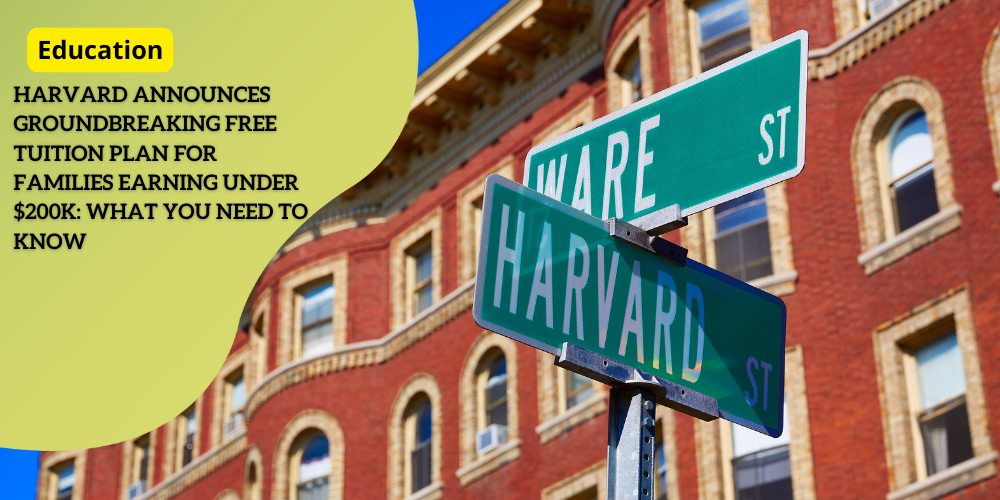Harvard Announces Groundbreaking Free Tuition Plan for Families Earning Under $200K: What You Need to Know

Breaking Down Harvard’s New Financial Aid Initiative 

Harvard University has recently announced a groundbreaking financial aid initiative aimed at making its education more accessible to middle and low-income families.
Starting in the 2025-2026 academic year, Harvard will provide free tuition for families earning up to $200,000 per year.
This initiative comes with the goal of expanding access to education, particularly for students who might have previously thought attending Harvard was financially out of reach.

Free Tuition for Families Earning Up to $200,000 
Under the new plan, families with annual incomes up to $200,000 will not have to pay any tuition fees. This is a significant move to relieve the financial burden on middle-income families.
Harvard’s annual tuition currently stands at $56,500, which is a considerable expense for many families. By eliminating tuition for this income bracket, the university aims to attract a more diverse and talented pool of students.
Complete Coverage for Families Earning Less than $100,000 

Harvard is taking its commitment one step further for families with even lower incomes.
Families earning under $100,000 annually will have all their educational expenses covered, including tuition, food, housing, and other additional costs.
These complete coverage packages help to ensure that students from the most financially disadvantaged backgrounds have the same opportunities to experience Harvard’s renowned education without the weight of financial stress.
Implementation Timeline 
The new financial aid program will take effect for the 2025-2026 academic year.
This timing provides the university administration ample opportunity to prepare for the roll-out and for families to plan accordingly.
With this lead time, prospective students and their families can better understand the financial aid they may qualify for and make informed decisions about applying to Harvard.
Moving forward, this initiative is designed to boost both academic and socioeconomic diversity, providing a richer learning environment for all students.
Harvard’s dedication to making higher education more accessible sets a promising trend within elite universities.
While this initiative is designed to welcome a wider array of future students, it ultimately serves the broader purpose of enhancing the overall educational experience through increased diversity and inclusion.
The Current Cost of Harvard Education 
When envisioning a Harvard education, most people see world-class professors, prestigious networking opportunities, and the iconic Cambridge campus.
However, few see the daunting price tag that accompanies such privileges.
As of the current academic year, Harvard’s annual tuition alone stands at a staggering $56,500. For many, the dream of attending this Ivy League institution feels financially out of reach.
Total Costs: More Than Just Tuition 

The cost of a Harvard education encompasses much more than just tuition.
When you factor in additional expenses such as food, housing, and other essential items, the total reaches a hefty $82,866 per year.
These expenses cover not only basic living costs but also items like textbooks, personal supplies, and fees for various university services.
Prospective students often need to consider these comprehensive expenses when evaluating whether they can afford a Harvard education.
Financial Aid: A Silver Lining 
There is a silver lining for accepted students and their families.
According to Harvard’s latest financial aid initiative, nearly 90% of U.S. families with accepted students will be eligible for some form of financial assistance.
This initiative is set to begin in the 2025-2026 academic year and promises to revolutionize access for many families.
Free tuition will be offered to students whose families have an annual income of up to $200,000, while families earning under $100,000 will receive complete coverage for all educational costs, including room and board.
This level of support underlines Harvard’s commitment to making education accessible regardless of financial circumstances.
The initiative is not merely about reducing the tuition fee—it is about ensuring that fewer students have to worry about how they will pay for textbooks, meals, or a place to live.
Transition to Broader Impact 
The financial burden of attending one of America’s most prestigious universities can be overwhelming, yet Harvard’s new financial aid directive signals a transformative shift for prospective students.
Exploring the immediate and long-term impact of these changes will show us how Harvard aims to attract a student community that is more diverse and inclusive, creating a richer educational environment for all.
This focus on socioeconomic diversity has far-reaching implications, setting a powerful precedent for other elite institutions.
Impact on Educational Access and Diversity 
Harvard’s new financial aid initiative represents a transformative approach to broadening educational access and amplifying diversity within its student body.
With the announcement that students from families earning up to $200,000 annually will receive free tuition, and students from families earning under $100,000 will have all costs covered, Harvard is taking a significant step forward.
Attracting Diverse Socioeconomic Backgrounds 
This initiative targets the systemic barriers that have historically limited middle-income and low-income families from considering elite education.
By providing full financial coverage, Harvard is aiming to attract a wide array of students, irrespective of their economic standing.
This is not just about easing the financial burden; it’s about breaking down the invisible barriers that make Harvard seem unattainable to many.
Accessibility for Middle-Income Families 
Middle-income families often fall into a tricky spot where they are not affluent enough to comfortably afford private college fees but also not poor enough to qualify for existing financial aid.
By extending free tuition, Harvard is acknowledging the financial strains that middle-income families face.
This initiative could be seen as a move to diversify further than just ethnic or racial lines – it is diversity in income, ensuring students from various financial backgrounds feel welcome.
Expanding Perspectives and Experiences 
One of the core benefits of this initiative is the promise of a richer, more varied academic environment.
Bringing together students from different walks of life can significantly enhance the learning experience for everyone.
Diverse perspectives foster creativity, critical thinking, and innovation.
Harvard President Alan Garber emphasized this by saying, “Putting Harvard within financial reach for more individuals widens the array of backgrounds, experiences, and perspectives that all of our students encounter, fostering their intellectual and personal growth.”
Transition to Broader Impact 
Harvard’s initiative is a step towards greater inclusivity and could influence other elite institutions to follow suit.
By enhancing access and embracing diversity, Harvard is setting a precedent that aligns with the broader national conversation on higher education accessibility.
Broader Trends in Elite Education Accessibility 
Similar Programs Announced by MIT, UMass, and University of Michigan
Harvard’s groundbreaking financial aid initiative, offering free tuition for families earning up to $200,000 annually, is not an isolated gesture.
Institution  |
Eligibility Criteria  |
Benefits  |
|---|---|---|
MIT  |
Families earning under $200,000 | Waived tuition fees, full coverage for students from families earning under $100,000   |
UMass  |
Massachusetts residents from families earning up to $75,000 | Tuition-free education at any of its four undergraduate campuses  |
University of Michigan  |
In-state students from families with combined income and assets up to $125,000 | Tuition-free education for eligible students   |
These initiatives are in response to the increasing number of headlines and surveys highlighting the financial challenges families face when considering higher education.
Response to Growing Concerns about College Affordability
Rising tuition and living costs have long been a barrier to accessing higher education for families across the United States.
Surveys indicate that many Americans are questioning the value of a college degree, with the percentage of high school graduates enrolling in colleges dipping to record lows not seen in decades.
Despite this, data consistently shows that individuals with bachelor’s degrees earn significantly more over their lifetimes compared to those with only high school diplomas.
Recognizing this dichotomy, these elite institutions have designed their financial aid programs to make college more accessible.
By significantly lowering the financial barrier, they address one of the most critical concerns parents and students have when considering higher education opportunities.
Alignment with Other Flagship Institutions’ Efforts to Increase Accessibility 

Harvard’s new financial aid initiative aligns with broader efforts among flagship institutions to democratize access to education.
This trend reflects a growing understanding that a more diverse and inclusive student body enriches the academic environment.
Welcoming students from varied economic backgrounds brings a mix of perspectives that enhances collective learning experiences.
By aligning their financial aid models, institutions like Harvard, MIT, UMass, and the University of Michigan are setting a new standard in higher education.
They are not only responding to economic realities but also reinforcing the importance of socioeconomic diversity within their campuses.
Harvard’s initiative, along with similar programs at other top universities, signifies an essential shift in how we view educational equity.
By tackling financial barriers head-on, these universities are paving the way for more comprehensive reforms that could reshape the landscape of American higher education.
Next, let’s explore how these changes resonate with the students themselves and what broader implications they might have for future application trends and diversity within elite institutions.
Student Perspectives and Future Implications 

With Harvard’s monumental announcement to offer free tuition for families making under $200,000 annually starting in the 2025-2026 academic year, the response from students has been overwhelmingly positive.
Current Harvard students and prospective applicants view the initiative as a significant step forward in making higher education more accessible and affordable, especially for middle-income families.
Positive Reception from Current Harvard Students 
Skye Lam, a 20-year-old undergraduate from New York City, expressed her enthusiasm about the new financial aid plan, highlighting its potential to make Harvard a viable option for more students who might otherwise not consider it due to financial constraints.
She mentioned that since she applied, many elite universities have increased their financial aid efforts, making higher education more attainable for students from diverse economic backgrounds.
Similarly, Kaine Bivens, an 18-year-old undergraduate from Fort Worth, Texas, who received a full scholarship due to his family’s income being less than $100,000, shared his excitement: “More kids are given an opportunity for an education,” he said. “A lot of times, cost is the reason that kids can’t get an education, so it’s really good that Harvard is trying its best to make sure they give people opportunities that need it.”
Potential Impact on Application Decisions and Diversity 

Harvard’s new financial aid initiative is expected to have far-reaching implications on application patterns and student diversity.
By reducing the financial barriers significantly, the university aims to attract a broader range of applicants, particularly from middle-income families who may have previously deemed Harvard financially out of reach.
This change could lead to an increase in applications from students with varied backgrounds, enriching the institution with a wider array of perspectives and experiences.
The promise of complete coverage for families earning under $100,000 is also likely to encourage students from lower-income backgrounds to apply, knowing that all their financial needs will be met.
This can shape a more diverse and inclusive campus environment, fostering intellectual and personal growth among students who can learn from each other’s unique experiences and viewpoints.
Addressing Broader Concerns about Higher Education Value and Accessibility 

Harvard’s initiative comes at a time when the rising cost of higher education has led many to question the value of a college degree.
Surveys indicate that fewer high school graduates are pursuing higher education, citing affordability as a major barrier.
By making such a bold move, Harvard is not only addressing these concerns but also setting a benchmark for other elite institutions to follow.
While critics argue that the plan primarily benefits wealthier families and does not fully resolve the issue of college affordability, it is still a noteworthy attempt to open doors wider for a significant portion of potential students.
It reflects an acknowledgment of the need for socioeconomic equity in accessing top-tier education and serves as a response to the political and societal pressures elite colleges face today.
As we look forward to the impacts of these changes, it’s evident that Harvard’s financial aid initiative has the potential to reshape the higher education landscape significantly.
The university’s dedication to enhancing education access for diverse students is likely to encourage other institutions to implement similar initiatives, fostering a more inclusive and equitable future for higher education.






